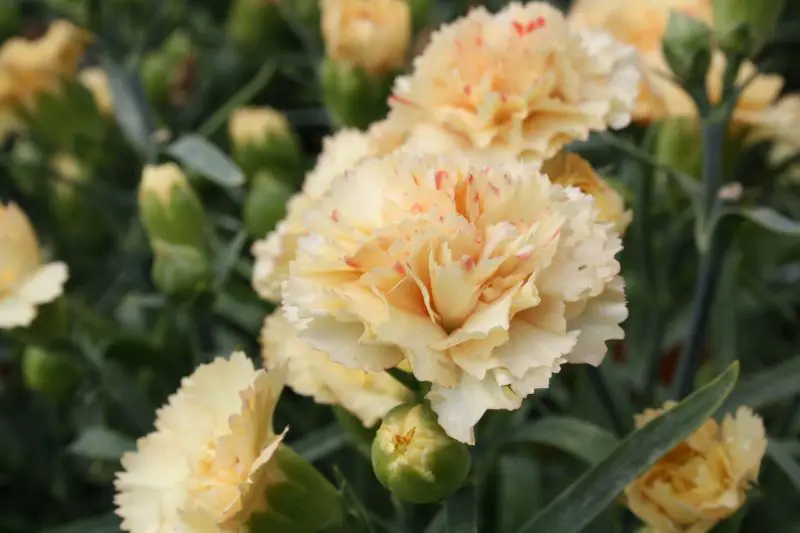With their ruffled petals, clove-like fragrance, and vibrant shades of pink, red, and white, dianthus flowers have long held a cherished place in gardens around the world. Whether cascading over rock walls, lining sunny borders, or blooming cheerfully in containers, these charming plants offer enduring beauty that seems almost effortless. But as gardeners admire their cheerful blooms, one question often arises: Is dianthus a perennial? Understanding the answer can transform how you grow and care for this beloved flower.
In this guide, you’ll uncover the secrets to keeping your dianthus blooming through every season. From understanding its perennial potential to mastering seasonal care, pruning techniques, and planting tips, we’ll walk you through everything you need to create a dianthus display that thrives year after year. Whether you’re a new gardener or a seasoned green thumb, this article will inspire you to give your dianthus the love and attention it deserves—all while ensuring its blooms never fade.
Understanding the Dianthus Bloom Cycle

The bloom cycle of dianthus is a fascinating process that reveals the plant’s natural rhythm and response to changing seasons. Depending on the variety, dianthus may bloom once, twice, or continuously throughout the growing season. Most perennial types, like Dianthus barbatus (Sweet William) and Dianthus plumarius (pinks), begin blooming in late spring and continue into early summer, with some varieties offering a second flush of flowers in fall if properly cared for. Annual varieties, such as Dianthus chinensis, often bloom steadily from spring until the first frost, especially when regularly deadheaded.
The blooming cycle typically begins with a period of vegetative growth in early spring as temperatures rise. During this phase, the plant develops new foliage and prepares to form buds. Once the buds swell and begin to open, the blooming phase starts—usually triggered by a combination of warm days, cool nights, and increasing daylight. After peak flowering, blooms will gradually fade unless they are removed, in which case many varieties will respond with renewed flower production. By midsummer or late summer, blooming may slow as plants enter a resting phase, especially in hotter climates.
Understanding this natural cycle allows gardeners to better support dianthus with timely pruning, feeding, and watering. Proper care during each stage ensures longer bloom times and healthier plants that return stronger each year.
When Do Dianthus Bloom in Different Climates?
Cool-Climate Regions
In regions with long winters and short, mild summers—such as USDA hardiness zones 3 to 6—dianthus generally begins its blooming cycle in late spring, typically around late May to early June. Perennial dianthus varieties overwinter beneath a layer of mulch or snow and re-emerge with fresh green growth as soon as temperatures consistently rise above freezing. Cool-climate conditions offer an ideal environment for prolonged blooming because the flowers are less likely to suffer from heat stress or drought. With proper deadheading and a steady supply of nutrients, dianthus can continue blooming steadily through July and August, sometimes even into early fall. These climates are especially suited to classic pinks and cottage-garden-style varieties that love cooler air and lower humidity.
Warm-Climate Zones
In USDA zones 7 to 10, dianthus starts blooming earlier, often in late March or early April. The warmer spring temperatures encourage faster bud development and vibrant flower displays. However, intense summer heat and strong afternoon sun can cause blooms to fade more quickly. To protect the plants, morning sun exposure combined with filtered or dappled afternoon shade is ideal. Mulching helps retain soil moisture and regulate temperature. Frequent watering and removing spent flowers support longer bloom times and can trigger a second flowering in early fall when temperatures cool down.
Tropical and Subtropical Areas
In zones 11 and higher, where temperatures stay warm year-round with high humidity, dianthus is grown mainly as an annual. Gardeners typically plant seeds or seedlings in fall or early winter, when cooler temperatures arrive. Dianthus then produces abundant flowers from late December through March, adding color during the tropical landscape’s cooler, drier months. As spring heat intensifies, flowering slows and plants may decline by early summer. Success depends on planting early enough in the cool season to enjoy the full bloom period before hot, humid weather causes dormancy or dieback.
How to Encourage Continuous Blooming
Deadheading Spent Flowers
Consistently removing faded or withered dianthus blooms is one of the most effective ways to promote ongoing flowering. This process, known as deadheading, prevents the plant from channeling energy into seed development and instead redirects that energy into producing new flower buds. Use clean, sharp scissors or pruners to snip off each spent flower just above a healthy set of leaves or side bud. Check your plants every few days during the blooming season and remove any flowers that are starting to fade. Regular deadheading not only keeps your dianthus looking tidy but also stimulates a fresh flush of vibrant blooms.
Providing Ideal Sunlight Conditions
Dianthus plants perform best when grown in full sun, meaning they receive at least six hours of direct sunlight per day. Adequate sunlight is critical for strong stem growth, dense foliage, and abundant flowering. In regions with intense afternoon heat, especially in USDA Zones 8 and above, providing light afternoon shade can help prevent stress and prolong blooming. If your plants are growing in too much shade, they may become leggy, stretch toward the light, and produce fewer flowers. Observe your garden throughout the day to ensure your dianthus receives enough light for optimal blooming.
Soil and Fertility Management
Healthy, long-lasting blooms depend heavily on good soil conditions. Dianthus prefers well-drained soil with a neutral to slightly alkaline pH (around 6.5 to 7.5). Avoid planting in heavy, water-retentive clay or acidic soils. Overly fertile soil, particularly one high in nitrogen, can cause excessive leafy growth at the expense of flowers. To encourage continuous blooming, feed your dianthus with a balanced, slow-release fertilizer (such as 10-10-10) once a month during the growing season. Alternatively, you can use a water-soluble bloom-boosting fertilizer every 3–4 weeks. Always follow label instructions and avoid over-fertilizing, which can do more harm than good.
Watering Wisely
Consistent yet controlled watering is key to supporting bloom production without stressing the plant. Dianthus prefers evenly moist soil but is highly sensitive to waterlogged conditions, which can cause root rot and drastically reduce flowering. Allow the top inch (2.5 cm) of soil to dry out between waterings. During hot, dry periods, deep watering once or twice a week is better than daily light watering, as it encourages roots to grow deeper and strengthens drought resistance. Always water at the base of the plant to keep foliage dry and prevent fungal problems, especially if you’re growing a dense or compact variety.
Pruning and Pinching for More Blooms
Early Season Pinching
Pinching back young dianthus plants when they reach about 4 to 6 inches (10–15 cm) tall encourages the development of multiple side branches. This results in a bushier plant with more stems that will eventually bear flowers. While pinching may slightly delay the initial bloom as the plant focuses on growing new shoots, the long-term benefit is a fuller, more floriferous plant. To pinch properly, use your fingers or clean pruning shears to remove the top growing tip of the main stem, which stimulates side buds to grow more vigorously.
Mid-Season Pruning
After the first wave of blooms fades, it’s beneficial to lightly prune the entire plant by cutting back about one-third of its height. This removes spent flowers and old or leggy growth, which rejuvenates the plant and encourages the development of new buds for a second bloom cycle later in the season. Follow up pruning with a balanced fertilizer high in phosphorus and potassium to support bud formation and overall plant health. This practice is especially effective for perennial dianthus varieties and helps extend the flowering period.
Late-Season Care
As fall approaches, allowing some flowers to go to seed is useful if you want the plant to self-seed naturally for the next growing season. For perennial dianthus, it’s important to remove any dead, damaged, or diseased stems and foliage to help the plant conserve energy during winter dormancy. This cleanup reduces the risk of disease and prepares the plant for vigorous growth in spring. Proper late-season care ensures healthier plants and more robust blooms in the following year.
Choosing the Right Varieties for Longer Blooms
Long-Blooming Dianthus Types
Certain dianthus varieties naturally offer longer and more consistent blooming periods. For example, ‘Firewitch’ is prized for its fragrant, vibrant pink flowers that bloom continuously over several months. Similarly, ‘Bath’s Pink’ is a classic garden favorite known for its rich color and repeat blooming throughout the season. When selecting dianthus, look for these varieties or those labeled as “ever-blooming” or “long-flowering” to enjoy an extended floral display in your garden. Their genetics provide stronger reblooming tendencies, making them ideal for gardeners who want sustained color without replanting.
Reblooming Hybrids
Thanks to modern breeding techniques, many new dianthus hybrids are available that have been specifically developed to rebloom repeatedly from spring until fall. The ‘EverBloom’ series, for instance, combines vibrant colors with excellent disease resistance and a vigorous reblooming habit. These hybrids require proper care, such as regular deadheading and balanced fertilization, to maintain their nonstop flowering cycle. Choosing reblooming hybrids is especially advantageous in climates with longer growing seasons, where continuous color is desired.
Compact vs Tall Varieties
When planning your garden design, consider the growth habit of dianthus varieties. Compact types, often called “miniature” or “dwarf” dianthus, tend to produce more tightly packed blooms and have a longer flowering period because their energy is focused on fewer, more concentrated stems. These are perfect for borders, rock gardens, or container planting. In contrast, taller varieties grow up to 18 inches or more and typically bloom in a shorter, more intense period. They often require staking to prevent flopping and work well as cut flowers or in mixed perennial beds where height variation adds visual interest. Knowing which growth habit suits your space and aesthetic goals helps maximize bloom enjoyment.
Seasonal Care Tips for Prolonged Flowering
Spring Maintenance
At the start of spring, it’s important to prepare your dianthus plants for a strong growing season. Begin by clearing away any dead leaves, old stems, and garden debris around the base of the plants. This reduces disease risk and allows better air circulation. Apply a light, balanced fertilizer to established plants to support fresh new growth and stimulate early bud formation. For young dianthus, consider pinching back the growing tips when plants reach about 4 to 6 inches tall. This encourages bushier growth and sets the stage for more abundant flowering. Consistent watering during this period, ensuring the soil stays moist but not soggy, also promotes healthy development.
Summer Management
During the peak bloom season in summer, the focus shifts to maintaining bloom longevity and overall plant vigor. Regular deadheading is crucial to prevent energy diversion into seed production and to encourage continuous flowering. Maintain consistent soil moisture by watering deeply but allowing the topsoil to dry slightly between waterings, as dianthus prefers well-drained conditions. Apply a balanced fertilizer with low nitrogen to avoid excessive leafy growth, which can reduce flower production. In regions with intense afternoon sun and high temperatures, providing light shade can protect delicate blooms from scorching and prolong their lifespan. Mulching can also help retain soil moisture and moderate root zone temperatures during hot spells.
Fall Transition
As temperatures start to drop in fall, dianthus plants begin to prepare for dormancy. At this stage, reduce both fertilization and watering to slow growth and encourage natural hardening off. Cut back any plants that have finished flowering or appear tired to tidy up the garden and prevent disease. For perennial varieties, fall is also an ideal time to divide overcrowded clumps every two to three years. Dividing rejuvenates plants by stimulating fresh root and shoot growth, leading to more vigorous flowering in the following spring. After dividing, replant immediately and water well to help new divisions establish before winter.
Overwintering Dianthus for Spring Blooms
Properly overwintering dianthus is key for healthy blooms next spring. As temperatures drop, perennial dianthus go dormant, conserving energy. Start by cutting back yellowing foliage to reduce disease risk. Apply a light mulch around the base to protect roots from cold, but keep mulch away from the crown to avoid rot.
In colder areas, use frost blankets, cloches, or bring container plants indoors to protect from freezing. Place containers in a cool, bright spot with good airflow. In milder climates, minimal protection is needed, but watch for soggy soil that can cause root issues.
In early spring, remove mulch carefully and prune damaged growth. Fertilize with a balanced, slow-release formula as new shoots appear and water adequately without overwatering. These steps help dianthus break dormancy and bloom beautifully each year.
Common Blooming Problems and How to Solve Them
No Flowers Appearing
When dianthus fails to produce flowers, one common cause is insufficient sunlight. Dianthus thrives in full sun, so plants shaded by trees or taller plants may grow lush foliage but no blooms. Another frequent issue is excessive nitrogen fertilization. High nitrogen levels promote leafy growth at the expense of flowers, so adjusting to a balanced fertilizer with moderate nitrogen can help restore blooming. Additionally, neglecting proper pruning can reduce flower production; overgrown or unpruned plants tend to focus energy on maintaining foliage rather than flowering. To fix this, prune back old stems and spent flowers regularly to encourage new bud formation and maintain a healthy plant structure.
Buds Forming But Not Opening
If your dianthus forms buds that fail to open, it could signal underlying stress factors. Water stress, either too much or too little, often disrupts bud development. Ensure consistent watering that keeps soil moist but not waterlogged. Insect pests such as aphids, thrips, or spider mites can damage buds by feeding on their delicate tissues, preventing full bloom. Regularly inspect plants and treat infestations promptly with insecticidal soap or natural predators. Extreme heat or intense direct sunlight during peak afternoon hours may also cause buds to shrivel or abort. Providing light shade during the hottest part of the day can alleviate heat stress and improve flower opening success.
Fewer Blooms Each Year
A gradual decline in flower production over successive seasons is common in older perennial dianthus. This often results from overcrowded root systems that compete for nutrients and space, limiting the plant’s ability to produce abundant blooms. Soil nutrient depletion can compound the problem if plants are not fertilized adequately or the soil is compacted. To revitalize blooming, divide overcrowded clumps every two to three years. This process involves carefully digging up the plant, separating healthy shoots with roots, and replanting them in well-prepared soil enriched with organic matter. Improving soil structure and fertility ensures that each division has access to the resources needed for vigorous growth and prolific flowering.
Maximizing Blooming Through Companion Planting
Maximizing blooming through companion planting involves selecting plants that not only complement dianthus visually but also support its growth and flowering potential. Choosing companions that attract beneficial pollinators such as bees and butterflies can increase pollination efficiency, leading to more abundant and healthier blooms. Plants like lavender and salvia are excellent companions because they thrive in similar growing conditions and draw pollinators without competing aggressively for nutrients. Additionally, pairing dianthus with plants that have different bloom times creates a continuous sequence of color and interest in the garden, preventing gaps once dianthus blooms fade. Companion planting can also help improve soil health by balancing nutrient uptake and reducing pest pressures naturally. For example, ornamental grasses planted nearby provide a contrasting texture while helping to deter pests that might otherwise target dianthus. Overall, thoughtful companion planting enhances the visual appeal of your garden and contributes to a longer, more prolific blooming season for your dianthus.
FAQs About Dianthus Blooming
When do dianthus usually start blooming?
Dianthus typically begins blooming in late spring, around May in temperate climates. Some varieties or warmer areas may see blooms as early as April. The flowering period can last longer if conditions like temperature and sunlight are favorable.
Can dianthus bloom more than once a season?
Many dianthus varieties can bloom multiple times per season with proper care. Regular deadheading and pruning encourage new growth and additional flowering cycles throughout the growing season.
Why isn’t my dianthus blooming?
Lack of blooms is often caused by insufficient sunlight, excessive nitrogen fertilizer, or failure to remove spent flowers. Environmental stress like extreme heat, uneven watering, or pests can also prevent flowering. Adjusting these factors usually helps restore bloom production.
How can I make dianthus bloom longer?
To extend bloom time, regularly deadhead spent flowers to direct energy into new buds. Provide at least six hours of sunlight daily, use balanced fertilizer, and water appropriately to support healthy, sustained flowering.
Do all dianthus types bloom at the same time?
No, bloom times vary among dianthus types. Annual varieties bloom quickly after planting and continue until frost, while perennials and hybrids may bloom once or rebloom intermittently throughout the season.
Final Thoughts on Dianthus Blooming and Longevity
Dianthus is a rewarding plant for any garden, offering elegance, fragrance, and extended color when cared for thoughtfully. Understanding when they bloom in your climate and applying a few simple techniques—such as deadheading, pruning, and proper feeding—can dramatically increase their flowering window. Whether grown in containers, borders, or rock gardens, these charming plants have the potential to provide lasting beauty across seasons.






